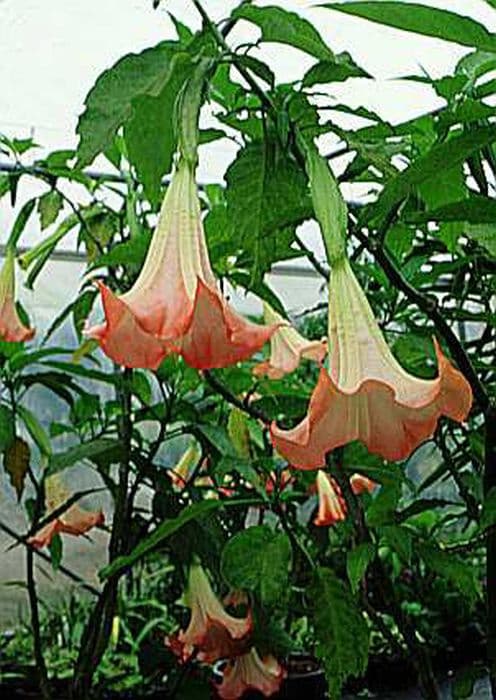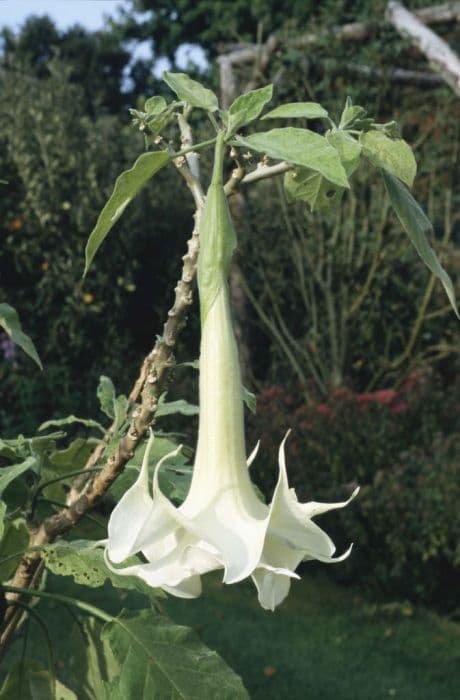Black Satin Petunia Petunia Black Satin = 'Dueswebsa' (PBR) (Sweetunia Series)
![petunia [Black Satin]](/_next/image?url=https%3A%2F%2Fplants-admin.emdemapps.com%2Fimages%2Fplants%2F%2Fimages%2F604b58a14676d.png&w=3840&q=75)
ABOUT
The Petunia Black Satin, belonging to the Sweetunia Series, is a striking plant primarily known for its unique and captivating flower coloration. The flowers of this petunia are characterized by their velvety, deep purplish-black hue which can appear almost true black under certain light conditions, resembling the luxurious fabric they are named after. These blooms are large with funnel-shaped blossoms that exhibit a soft yet dramatic appearance, inviting visual interest. The flowers are often contrasted by the bright green foliage that provides a lush backdrop, showcasing the rich tones of the petals. This petunia variety is prized for its continuous blooming habit, offering a long season of color as the plant produces an abundance of flowers that blanket the foliage in waves. The overall visual effect of the Petunia Black Satin is one of sophisticated elegance and rich, saturated color, making it a popular choice for adding a touch of drama to garden beds, containers, or hanging baskets.
About this plant
 Names
NamesFamily
Solanaceae
Synonyms
Black Satin Petunia, Sweetunia Black Satin
Common names
Petunia Black Satin 'Dueswebsa' (PBR) (Sweetunia Series).
 Toxicity
ToxicityTo humans
Petunias, including the Black Satin Petunia, are generally considered non-toxic to humans. They do not contain substances known to be poisonous and are not associated with adverse health effects upon ingestion. Therefore, if someone inadvertently consumes parts of a Black Satin Petunia, it is unlikely to cause poisoning or harmful symptoms. However, it is always advisable to avoid eating ornamental plants due to potential pesticide residue and the possibility of individual allergic reactions.
To pets
Petunias, including the Black Satin Petunia, are also generally regarded as non-toxic to pets. They are not known to contain any compounds that are harmful to dogs, cats, or other household pets. Consequently, if a pet consumes parts of a Black Satin Petunia, they are unlikely to experience symptoms of poisoning or suffer any serious consequences. Nevertheless, ingestion of ornamental plants should be discouraged as a precautionary measure to prevent potential stomach upset from non-digestible plant matter or sensitivities.
 Characteristics
CharacteristicsLife cycle
Annuals
Foliage type
Deciduous
Color of leaves
Green
Flower color
Black
Height
1 foot (30 cm)
Spread
1 foot (30 cm)
Plant type
Herb
Hardiness zones
9
Native area
South America
Benefits
 General Benefits
General Benefits- Attractive Blooms: Petunia Black Satin is known for its deep purple to black velvety flowers, adding a striking visual appeal to gardens and landscapes.
- Long Flowering Season: This petunia typically offers a long season of blooms from spring through frost, providing consistent color and interest.
- Compact Growth Habit: With a mounded and compact growth habit, it fits well in containers, hanging baskets, and small garden spaces without becoming leggy.
- Drought Tolerance: Once established, it can withstand periods of low water, making it suitable for xeriscaping and reducing the need for frequent watering.
- Low Maintenance: This variety of petunia is relatively easy to care for, requiring minimal maintenance beyond regular watering and occasional feeding.
- Versatility: It can be used in various garden settings, including borders, beds, and as a ground cover due to its spreading nature.
- Attracts Pollinators: The colorful and nectar-rich flowers are attractive to butterflies and hummingbirds, promoting biodiversity.
 Medical Properties
Medical PropertiesThis plant is not used for medical purposes.
 Air-purifying Qualities
Air-purifying QualitiesThis plant is not specifically known for air purifying qualities.
 Other Uses
Other Uses- Natural Fabric Dye: The deep pigmentation of the Black Petunia can be used to produce a unique, dark dye for textiles.
- Photography Subject: Due to their striking appearance, Black Petunias can serve as a dramatic subject for botanical photography.
- Educational Tool: Black Petunias can be used to explain the concepts of hybridization and genetic variation to students and gardening enthusiasts.
- Theme Gardens: They are perfect for creating a 'gothic' themed garden or for use in Halloween displays due to their dark blooms.
- Art Inspiration: Their unique color can inspire artists to use them as subjects in paintings or as part of a color palette in their artwork.
- Event Decorations: They can be used as live decor in nighttime events, where their dark flowers can create a sophisticated ambiance.
- Culinary Garnish: Although not commonly consumed, the petals can be used as an ornamental garnish for certain dishes to add visual drama.
- Ice Cubes: Freeze petals in ice cubes to create visually stunning drinks for special occasions.
- Color Contrasting: Plant them alongside brightly colored flowers to create a visually striking contrast in a garden or flower arrangement.
- Performance Art: Incorporate Black Petunias into costumes or stage settings for dramatic effect in theatrical performances.
Interesting Facts
 Feng Shui
Feng ShuiPetunia is not used in Feng Shui practice.
 Zodiac Sign Compitability
Zodiac Sign CompitabilityPetunia is not used in astrology practice.
 Plant Symbolism
Plant Symbolism- Anger and Resentment: Black petunias, like the 'Black Satin', can symbolize anger or resentment due to their dark hues, representing more negative emotions.
- Sophistication and Elegance: The deep color and unique appearance of the Black Satin petunia can also signify sophistication and elegance, making it a chic addition to modern gardens.
- Mysticism and the Occult: Black flowers are often associated with mystery and the occult, and Black Satin petunias can evoke a sense of the mystical or otherworldly.
- Transformation and Change: Due to the rarity of true black flowers in nature, Black Satin petunias can represent transformation and change, symbolizing new beginnings or a departure from the traditional.
- Strength and Survival: The ability of the Black Satin petunia to thrive in various conditions can be seen as a symbol of strength and resilience.
 Water
WaterPetunias, including the Black Satin variety, should be watered thoroughly when the top inch of soil feels dry to the touch, which typically means once every 7 to 10 days, depending on weather conditions. Ensure even watering across the soil to reach the roots. Water deeply enough so that the water reaches the entire root system, but avoid waterlogging the soil, which can lead to root rot. It's recommended to provide about one gallon of water per square foot of soil every week during the growing season. During hot spells, you might need to water more frequently to maintain consistent soil moisture.
 Light
LightPetunias, including the Black Satin variety, thrive in full sun conditions, which means they need at least six to eight hours of direct sunlight daily. The ideal spot for these petunias would be an area that receives uninterrupted sunlight for most of the day. Avoid placing them in heavily shaded areas, as this will reduce blooming and can lead to leggy growth.
 Temperature
TemperaturePetunias, including the Black Satin variety, can tolerate a considerable range of temperatures but thrive best when daytime temperatures are between 60°F and 85°F. They can survive minimum temperatures of around 40°F, but frost can damage or kill the plants. During extreme heat, especially when temperatures exceed 90°F, petunias may suffer from stress and require additional care to maintain their health.
 Pruning
PruningPruning petunias, including the Black Satin variety, encourages bushier growth and more blooms. Pinch or cut back the stems by a few inches when the plant starts to look leggy or after a flush of blooms begins to fade. Pruning is best done in the early part of the growing season and can be repeated periodically throughout the summer to help the plant maintain its shape and promote continuous flowering.
 Cleaning
CleaningAs needed
 Soil
SoilPetunias thrive in a soil mix that is light, well-draining, and enriched with organic matter such as peat moss, compost, or well-rotted manure. Aim for a pH between 5.5 and 6.5 to ensure optimal nutrient uptake and a healthy plant.
 Repotting
RepottingPetunias generally do not require frequent repotting and can flourish in the same pot for an entire growing season. Repotting annually, or when you notice the plant has outgrown its current container, is sufficient.
 Humidity & Misting
Humidity & MistingPetunias are adaptable to a wide range of humidity levels but perform best in moderate conditions. They do not require high humidity and can tolerate the humidity levels typically found in outdoor environments.
 Suitable locations
Suitable locationsIndoor
Ensure bright light and good air circulation for indoor Petunias.
Outdoor
Place in full sun in well-draining soil and deadhead spent blooms.
Hardiness zone
10-11 USDA
 Life cycle
Life cycleThe life cycle of the Petunia Black Satin ('Dueswebsa') begins with germination, where the seeds require light and warm temperatures to sprout. Following emergence, the seedling stage is characterized by the growth of cotyledons and the development of true leaves. As the plant enters the vegetative stage, it experiences rapid growth and produces a robust system of stems and leaves, preparing for flowering. The flowering stage reveals the Petunia Black Satin's distinctive, dark-colored blooms which attract pollinators for reproduction. After pollination, the plant develops seeds within its spent flowers, signaling the onset of the reproductive stage. Finally, as the growing season concludes, the plant will enter senescence, where it naturally starts to deteriorate unless it is an annual, in which case it completes its life cycle within a single season.
 Propogation
PropogationPropogation time
Spring-Early Summer
The Petunia Black Satin, part of the Sweetunia Series, is often propagated by cuttings. This method is most popular due to its simplicity and efficiency. Cuttings are ideal when performed in late spring or early summer, providing warmth which aids in quicker rooting. A healthy, non-flowering stem is chosen and cut to about 3 to 4 inches long, with the leaves removed from the lower half. The cut end is dipped in a rooting hormone powder to encourage root growth and then inserted into a moist potting mix. It is essential to maintain a humid environment around the cutting, which can be achieved by covering the pot with a plastic bag. Roots generally begin to form within a few weeks, after which the new Petunia plants can be transplanted.


![Calibrachoa [Aloha Classic Blue Sky]](/_next/image?url=https%3A%2F%2Fplants-admin.emdemapps.com%2Fimages%2Fplants%2F%2Fimages%2F604b636c3778b.png&w=640&q=75)
![Calibrachoa [Aloha Classic Gold]](/_next/image?url=https%3A%2F%2Fplants-admin.emdemapps.com%2Fimages%2Fplants%2F%2Fimages%2F604b6284c573e.png&w=640&q=75)
![Calibrachoa [Aloha Classic Tiki Soft Pink]](/_next/image?url=https%3A%2F%2Fplants-admin.emdemapps.com%2Fimages%2Fplants%2F%2Fimages%2F604b548e0a5ef.png&w=640&q=75)
![Calibrachoa [Cabaret Deep Yellow]](/_next/image?url=https%3A%2F%2Fplants-admin.emdemapps.com%2Fimages%2Fplants%2F%2Fimages%2F604b5f20ca3ef.png&w=640&q=75)
![Calibrachoa [Calibasket Radiant Orange]](/_next/image?url=https%3A%2F%2Fplants-admin.emdemapps.com%2Fimages%2Fplants%2F%2Fimages%2F604b536d43cb2.png&w=640&q=75)
![Calibrachoa [Caloha Classic Blue Velvet]](/_next/image?url=https%3A%2F%2Fplants-admin.emdemapps.com%2Fimages%2Fplants%2F%2Fimages%2F604b604884a75.png&w=640&q=75)
![Calibrachoa [Caloha Classic Honey White]](/_next/image?url=https%3A%2F%2Fplants-admin.emdemapps.com%2Fimages%2Fplants%2F%2Fimages%2F604b5f56e0beb.png&w=640&q=75)
![Calibrachoa [Caloha Classic Yellow Chocolate Ring]](/_next/image?url=https%3A%2F%2Fplants-admin.emdemapps.com%2Fimages%2Fplants%2F%2Fimages%2F604b538aede95.png&w=640&q=75)